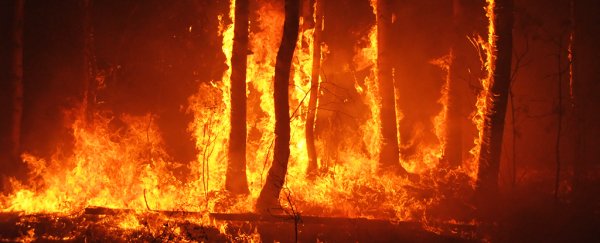In a hugely detailed and comprehensive new study, researchers have painted a picture of how around a tenth of Earth's surface suddenly became covered in roaring fires at a point some 12,800 years ago.
The firestorm rivals the one that wiped out the dinosaurs, and it was caused by fragments of a comet that would have measured around 100 kilometres (62 miles) across.
As dust clouds smothered the Earth, it kicked off a mini ice age that kept the planet cool for another thousand years, just as it was emerging from 100,000 years of being covered in glaciers. Once the fires burned out, life could start again, according to the international team of scientists.
"The hypothesis is that a large comet fragmented and the chunks impacted the Earth, causing this disaster," says one of the team, Adrian Melott from the University of Kansas.
"A number of different chemical signatures – carbon dioxide, nitrate, ammonia and others – all seem to indicate that an astonishing 10 percent of the Earth's land surface, or about 10 million square kilometres [3.86 million square miles], was consumed by fires."
To peer back into the burning fires and shock waves of this major event, a large number of geochemical and isotopic markers were measured from more than 170 sites across the world, involving a team of 24 scientists.
One of the pieces of analysis carried out was on patterns in pollen levels, which suggested pine forests were suddenly burned off to be replaced by poplar trees – a species specialising in covering barren ground, as you might get when your planet has been hit by a series of massive fireballs.
In fact parts of the comet that disintegrated in space are still likely to be floating around parts of our Solar System 13,000 years later.
High concentrations of platinum – often found in asteroids and comets – and high levels of dust were also noted in the samples analysed by the researchers, alongside increased concentrations of combustion aerosols you would expect to see if a lot of biomass was burning: ammonium, nitrate, and others.
Plants died off, food sources would have been scarce, and the previously retreating glaciers began to advance again, say the researchers. Human culture would have had to adapt to the harsher conditions, with populations declining as a result.
"Computations suggest that the impact would have depleted the ozone layer, causing increases in skin cancer and other negative health effects," says Melott.
The team thinks such a widespread impact of comet fragments, and the ensuing firestorm, is responsible for that extra bit of cooling known as the Younger Dryas period. This relatively brief blip in the planet's temperature has sometimes been put down to changing ocean currents.
However, the comet hit isn't a completely new idea, even though this latest research goes into a great deal of depth to try and find evidence for it. Scientists have been debating whether a comet impact kicked off the Younger Dryas event for several years now.
Not everyone agrees that the data points to a comet strike, but the new study offers up more support for the hypothesis, as do the ancient carvings found in Turkey last year – carvings which depict a devastating impact from an interstellar object.
"The impact hypothesis is still a hypothesis, but this study provides a massive amount of evidence, which we argue can only be all explained by a major cosmic impact," says Melott.
The research has been published here and here in the Journal of Geology.
